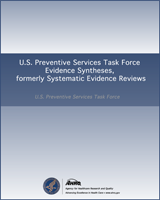NCBI Bookshelf. A service of the National Library of Medicine, National Institutes of Health.
This publication is provided for historical reference only and the information may be out of date.
Structured Abstract
Context:
Hormone replacement therapy (HRT) is widely used to prevent osteoporosis and fractures.
Objective:
To systematically review and evaluate studies of the use of estrogen and selective estrogen receptor modulators (SERMs) to prevent bone loss and fractures in healthy postmenopausal women.
Data Sources:
Studies with English language abstracts identified in MEDLINE, HealthSTAR, and Cochrane Library databases from 1994 to May 2001. Reference lists of key articles and meta-analyses were also reviewed.
Study Selection:
Only randomized controlled trials and cohort studies were included.
Data Extraction:
Studies meeting inclusion criteria were formally abstracted and quality was rated using criteria developed by the U.S. Preventive Services Task Force (USPSTF).
Data Synthesis:
For bone density outcomes, randomized controlled trials consistently indicated improved bone density with estrogen use. These findings were similar between prevention and treatment trials, opposed and unopposed regimens, oral and transdermal forms of estrogen, and types of progestins. For fracture outcomes, 5 randomized controlled trials of estrogen were identified and none met criteria to be ranked as a good-quality study. A primary prevention trial indicated a significant decrease in risk of nonvertebral fractures in 1 of 2 estrogen arms. None of the other trials indicated a significant risk reduction with estrogen, but all had important methodologic limitations. A recent meta-analysis of 22 trials of estrogen, many with unpublished data, reported an overall 27% reduction in nonvertebral fractures (relative risk [RR], 0.73; confidence interval [CI], 0.56–0.94). Six good-quality cohort studies were identified, and 3 of 4 studies reported 20% to 35% reductions in adjusted relative risks for hip fractures among ever users.
In randomized controlled trials, raloxifene increased bone density at lumbar spine, hip, and wrist sites, and tamoxifen modestly increased bone density at the hip and spine, although results were inconsistent between studies. The largest trial of raloxifene reported a protective effect for vertebral fractures (RR, 0.59; 95% CI, 0.05–0.70), but not for nonvertebral fractures. A large trial of tamoxifen indicated no statistically significant fracture benefit.
Conclusions:
The results of these studies support a benefit for estrogen in improving bone density and protecting against fractures, although the evidence for fractures is based on one arm of one randomized controlled trial and good-quality cohort studies. Trials indicate that raloxifene increases bone density and protects against vertebral fractures.
Contents
Prepared for: Agency for Healthcare Research and Quality, U.S. Department of Health and Human Services.1 Contract No. 290-97-0018, Task Order No. 2, Technical Support of the U.S. Preventive Services Task Force. Prepared by: Oregon Health Sciences University Evidence-based Practice Center, Portland, Oregon.
This report may be used, in whole or in part, as the basis for development of clinical practice guidelines and other quality enhancement tools, or a basis for reimbursement and coverage policies. AHRQ or U.S. Department of Health and Human Services endorsement of such derivative products may not be stated or implied.
AHRQ is the lead Federal agency charged with supporting research designed to improve the quality of health care, reduce its cost, address patient safety and medical errors, and broaden access to essential services. AHRQ sponsors and conducts research that provides evidence-based information on health care outcomes; quality; and cost, use, and access. The information helps health care decisionmakers—patients and clinicians, health system leaders, and policymakers—make more informed decisions and improve the quality of health care services.
The authors of this report are responsible for its content. Statements in the report should not be construed as endorsement by the Agency for Healthcare Research and Quality or the U.S. Department of Health and Human Services of a particular drug, device, test, treatment, or other clinical service.
- 1
2101 East Jefferson Street, Rockville, MD 20852. www
.ahrq.gov
- Review Screening to Prevent Osteoporotic Fractures: An Evidence Review for the U.S. Preventive Services Task Force[ 2018]Review Screening to Prevent Osteoporotic Fractures: An Evidence Review for the U.S. Preventive Services Task ForceViswanathan M, Reddy S, Berkman N, Cullen K, Middleton JC, Nicholson WK, Kahwati LC. 2018 Jun
- Review Postmenopausal hormone replacement therapy: scientific review.[JAMA. 2002]Review Postmenopausal hormone replacement therapy: scientific review.Nelson HD, Humphrey LL, Nygren P, Teutsch SM, Allan JD. JAMA. 2002 Aug 21; 288(7):872-81.
- Review Low-Dose Aspirin for the Prevention of Morbidity and Mortality From Preeclampsia: A Systematic Evidence Review for the U.S. Preventive Services Task Force[ 2014]Review Low-Dose Aspirin for the Prevention of Morbidity and Mortality From Preeclampsia: A Systematic Evidence Review for the U.S. Preventive Services Task ForceHenderson JT, Whitlock EP, O'Conner E, Senger CA, Thompson JH, Rowland MG. 2014 Apr
- Review Aspirin Use in Adults: Cancer, All-Cause Mortality, and Harms: A Systematic Evidence Review for the U.S. Preventive Services Task Force[ 2015]Review Aspirin Use in Adults: Cancer, All-Cause Mortality, and Harms: A Systematic Evidence Review for the U.S. Preventive Services Task ForceWhitlock EP, Williams SB, Burda BU, Feightner A, Beil T. 2015 Sep
- Review Meta-analyses of therapies for postmenopausal osteoporosis. IV. Meta-analysis of raloxifene for the prevention and treatment of postmenopausal osteoporosis.[Endocr Rev. 2002]Review Meta-analyses of therapies for postmenopausal osteoporosis. IV. Meta-analysis of raloxifene for the prevention and treatment of postmenopausal osteoporosis.Cranney A, Tugwell P, Zytaruk N, Robinson V, Weaver B, Adachi J, Wells G, Shea B, Guyatt G, Osteoporosis Methodology Group and The Osteoporosis Research Advisory Group. Endocr Rev. 2002 Aug; 23(4):524-8.
- Hormone Replacement Therapy and OsteoporosisHormone Replacement Therapy and Osteoporosis
Your browsing activity is empty.
Activity recording is turned off.
See more...

